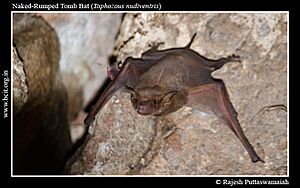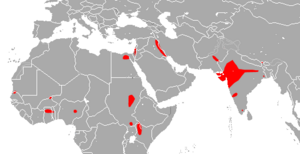Naked-rumped tomb bat facts for kids
Quick facts for kids Naked-rumped tomb bat |
|
|---|---|
 |
|
| Conservation status | |
| Scientific classification | |
| Genus: |
Taphozous
|
| Species: |
nudiventris
|
 |
|
| Naked-rumped tomb bat range | |
The naked-rumped tomb bat (Taphozous nudiventris) is a type of sac-winged bat. These bats belong to a family called Emballonuridae. You can find them in many places, including northern Africa, the Middle East, and parts of southeastern Asia. They like to live in dry areas like savannas, dry shrublands, and forests. They also make their homes in caves and very dry places.
Contents
What Does the Naked-Rumped Tomb Bat Look Like?
The naked-rumped tomb bat is a medium-sized bat. Male bats are usually a little bigger than females. Their heads are quite flat, and they have a long, cone-shaped nose. There's a small dip between their large eyes.
Their lower lip has a special groove. Their ears are shaped like triangles and point backward. These bats do not have a nose-leaf (a special skin flap on the nose). Male bats have well-developed throat pouches, which are smaller in females.
Their fur is short and smooth. It covers most of their body, but not their rump (bottom), lower belly, or back legs. There's a clear line where the fur stops and the bare skin begins. About one-third of their body surface has no hair. Their back fur can be light grayish-brown, dark brown, or rusty-brown. Their belly fur is lighter than their back. Their wing membranes are dark brown. The tail sticks out freely from the top of the skin between their back legs.
Where Do These Bats Live?
This bat lives in many areas across northern Africa and western Asia. Its home range stretches from Morocco and parts of Africa south of the Sahara Desert. It goes through Egypt and the Middle East all the way to Pakistan and India.
You can find them in dry and semi-dry places, as well as in tropical forests. They need open areas to hunt and good places to rest. They often roost in rocky spots or underground. Sometimes, they live near human towns, but they don't like too much noise or disturbance where they rest.
How Do Naked-Rumped Tomb Bats Live?
The naked-rumped tomb bat is very quick and moves well. It flies fast and high in open spaces, catching insects in the air. These bats are social, meaning they live in groups. They start to become active about 30 minutes before the sun sets. They fly out from their daytime resting spots shortly after sunset.
Their diet includes many different insects. They eat beetles, moths, grasshoppers, crickets, cockroaches, and flying ants. They rest together in groups. They find shelter in cracks between stones, in caves, on cliffs, in old ruins, and in old buildings.
For example, in Egypt, some of these bats rest in the famous Karnak Temple Complex. They share this space with other bat species, but each kind of bat has its own special spot. In Iraq and Pakistan, these bats travel every year. They rest in cool caves and buildings and store up fat in the summer. In winter, they move to warmer buildings. They might even go into a state of torpor (a light sleep) to save energy.
Life Cycle and Young Bats
For most of the year, male and female bats rest together. However, the males move to other roosting spots before the baby bats are born. When a new-born bat is very young, it clings to its mother while she flies. Later, the young bats rest next to their mothers. They stay behind while their mothers go out to find food. Even when they start to fly and hunt for themselves, the young bats often go with their parents.
A mother bat is pregnant for about nine weeks. Owls and hawks sometimes hunt these bats. Hawks might even catch them as they leave their resting places at sunset.
What is Their Conservation Status?
The naked-rumped tomb bat lives in a very large area. This includes northern and Central Africa, the Middle East, and southern Asia. They are not very common in western Africa, where they usually live in small groups. However, they are more common in eastern Africa, where they form large colonies. They are also common in southern Asia.
Overall, their numbers seem to be going down a bit. They can handle some disturbance from humans in their homes. But some groups of bats might be harmed by the use of pesticides (chemicals used to kill insects). They don't face many big threats. The International Union for Conservation of Nature has said that their conservation status is "least concern". This means they are not currently in danger of disappearing.


